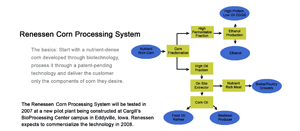Quality Traits: Linking the Chain from Farmer to Producer









October 2, 2006
BY Holly Jessen
Renessen's Corn Processing System isn't just about separating corn into its various usable parts. The company, a 50-50 joint venture between Cargill Inc. and Monsanto Company, goes beyond fractionation by focusing on quality traits, according to Mike Stern, Renessen CEO.
This method provides added benefits to everyone involved. "We're linking the chain," Stern tells EPM. "We start with the farmer, who is growing a value-enhanced crop, and we link it all the way to an animal producer or an ethanol producer, who is going to derive some benefit from it as well."
The system starts with Renessen's own corn hybrid, which, in February, became the company's first biotechnology product approved for sale in the United States. Renessen's high-value corn with lysine, trademarked under the name Mavera, has increased levels of oil and added lysine, Stern says. Fractionating the corn with Renessen's Corn Processing System will produce starch for ethanol production, lysine-rich swine feed, corn oil for food or biodiesel, and improved distillers dried grains with solubles (DDGS). "We've been able to develop a process that allows us to separate the components of the corn and deliver them to the end users that value them most," Stern says.
While there are a number of different fractionation technologies out there, the Renessen system is different, says Jeff Kazin, general manager of the Renessen Corn Processing System technology. Renessen's technology provides maximized oil and nutrient recovery rates, and can be used to fractionate both biotech corn and conventional corn. To top it all off, the system costs significantly less than other fractionation technologies out there, Kazin tells EPM.
Bearing Fruit
Since its formation in 1999, Renessen has immersed itself in research and development of quality traits for corn and soybeans. Early on in the process, the company also began investigating processing and oil extraction technologies to work hand-in-hand with the higher nutrient densities of its hybrid products, Kazin says. This year, that commitment is bearing fruit.
A limited amount of the high-value corn with lysine was planted on test acres in Iowa this year, with expanded acres planned for 2008. That corn will be used to feed the company's $15 million pilot corn processing plant, currently under construction at a Cargill site in Eddyville, Iowa, Stern says. The pilot plant will delve solely into the fractionation and oil extraction end of the technology, and will not include an on-site ethanol plant, he says.
However, by the end of 2008 or beginning of 2009, Renessen hopes the technology will be utilized at a 100 MMgy ethanol plant. The company is in the process of talking with potential partners, Stern tells EPM, and was unable to make an announcement on specifics at press time.
Beyond that, the company hasn't settled on its exact business model for providing the technology to ethanol producers. "Right now, we are really focused on proving the technology, but our intent is to make the technology very broadly available," Stern says.
Company Genesis
Renessen surfaced when the biotechnology industry was just beginning to emerge as a transformational agricultural technology in the marketplace, Stern says. It was also just a few years after Monsanto launched its Roundup Ready soybeans. While developing agronomical traits to kill bugs and weeds, Monsanto also recognized the value of developing quality traits.
The company had the broad-based technology infrastructure to develop quality traits. However, it realized that the value of a quality trait comes at the grain processing and animal production end of the spectrum, Stern tells EPM. While it all starts in the field, ultimately corn or soybeans are processed or fed to animals.
At the same time, Cargill recognized biotechnology would be a driving force in agriculture. While the company didn't have the infrastructure to develop biotechnology, it did have a large infrastructure in global grain handling, and grain processing and animal production.
Recognizing how their capabilities fit together, Cargill and Monsanto teamed up to form Renessen. The company, which is located in Deerfield, Ill., near Chicago, focuses on increasing the value of corn and soybeans by developing hybrids with quality traits, such as altered energy levels, amino acid levels or protein quantities. "Renessen is here to bring the second wave of biotechnology to the marketplace, and that's going to be around enhanced grain and quality traits," Stern says.
The project was about retrieving the nutrients Renessen put into its hybrid corn, Kazin says. The company has developed a low-cost way to extract oil from corn while retaining feed value, such as lysine levels. "The Renessen system puts more value into corn, and the next step is to be able to extract that value," Kazin tells EPM.
Since the joint venture was established, each company has averaged a yearly investment of about $30 million into Renessen, Stern says. Today, the company has 40 employees worldwide, with 25 of them located in the United States. Beyond that, Renessen also has access to more than 200 Cargill and Monsanto employees.
Adding Value
The growth of the ethanol industry is certainly something Renessen has kept its eye on as it develops its fractionation technology, Stern says. The company believes the ethanol industry is searching for a way to upgrade from raw material corn, which includes a lot of unfermentables. "If they could process … a more pure starch fraction, the efficiencies of these ethanol facilities would be improved," he says. Using the high-starch portion of a corn kernel, or the endosperm, will allow an ethanol facility to better produce primary product. "It's about them utilizing their assets more efficiently," Stern adds.
Another positive is that an ethanol facility utilizing fractionated corn as its feedstock would produce about 30 percent to 40 percent less DDGS, which right now is in high supply. Furthermore, the amount that is produced is higher in protein and lower in oil, making it more valuable in the marketplace. "We look at our technology as a way for an ethanol facility to differentiate itself on the DDGS side from all the other ethanol facilities," Stern says, calling it a fundamental change in the production of DDGS.
Kazin looks at it as a way for ethanol plants to diversify—almost creating a new business with its improved DDGS, he says. That business won't be subject to the same ethanol market ups and downs. "Margins won't always be as good," he says. "I think everybody realizes that."
The next product, the germ, is where Renessen's corn hybrid really shines. Oil extracted from the germ can be used for corn oil for food or biodiesel production, Stern says. The high-oil corn contains about 6.5 percent to 7 percent oil, where typical No. 2 yellow corn is about 3.5 percent oil. That's a possible boon for the biodiesel industry, which will need more sources of vegetable oil in the future, Kazin says. While Renessen is starting out with food-grade oil, there are plans to work toward industrial-grade oil.
What is left over after the corn oil is extracted is a nutrient-rich material suitable for swine feed, Stern says. The lysine in Renessen's high-value corn with lysine comes through the process, becoming concentrated in the feed material, Stern tells EPM. About 30 percent of the corn that goes into the system can be sold as swine feed. That's important because DDGS isn't as nutritionally suited for swine as it is for cattle, Stern says. Unlike cattle, swine require lysine, an amino acid, for growth.
This new feed could be especially good in a state like Iowa, for example, which produces about 30 million hogs a year. With ethanol production numbers growing, competition between corn for hog feed and corn for fuel puts pressure on corn prices. "We're already beginning to see that happen," he says, adding that it isn't just happening in Iowa.
Because the cattle industry isn't as large in Iowa, however, much of the DDGS produced in that state gets shipped elsewhere. With the Renessen Corn Processing System, ethanol producers could produce swine feed with lysine and lower the amount of DDGS it has to market, Stern says.
The hybrid has positives for farmers as well. In addition to earning a premium for growing the product, by about 2009, the company plans to offer the corn seed stacked with all of Monsanto's key agronomic traits, Roundup Ready, YieldGard Corn Borer and YieldGard Rootworm, Stern says. So the corn, as well as being a value-added technology, will perform well in the field. "Farmers are very, very interested in it," he says. "Our program is going to allow them to increase their net revenue per acre, and that's really what a farmer is looking for."
Through the years, there have been a lot of corn hybrids that have suffered "yield drag" because the hybrids didn't include agronomic traits, Kazin says. In the end, yield is really what's important. Renessen's hybrid is more effective with increased value while retaining yield. "It packs more value into every kernel," he says.
Holly Jessen is an Ethanol Producer Magazine staff writer. Reach her at hjessen@bbibiofuels.com or (701) 746-8385.
This method provides added benefits to everyone involved. "We're linking the chain," Stern tells EPM. "We start with the farmer, who is growing a value-enhanced crop, and we link it all the way to an animal producer or an ethanol producer, who is going to derive some benefit from it as well."
The system starts with Renessen's own corn hybrid, which, in February, became the company's first biotechnology product approved for sale in the United States. Renessen's high-value corn with lysine, trademarked under the name Mavera, has increased levels of oil and added lysine, Stern says. Fractionating the corn with Renessen's Corn Processing System will produce starch for ethanol production, lysine-rich swine feed, corn oil for food or biodiesel, and improved distillers dried grains with solubles (DDGS). "We've been able to develop a process that allows us to separate the components of the corn and deliver them to the end users that value them most," Stern says.
While there are a number of different fractionation technologies out there, the Renessen system is different, says Jeff Kazin, general manager of the Renessen Corn Processing System technology. Renessen's technology provides maximized oil and nutrient recovery rates, and can be used to fractionate both biotech corn and conventional corn. To top it all off, the system costs significantly less than other fractionation technologies out there, Kazin tells EPM.
Bearing Fruit
Since its formation in 1999, Renessen has immersed itself in research and development of quality traits for corn and soybeans. Early on in the process, the company also began investigating processing and oil extraction technologies to work hand-in-hand with the higher nutrient densities of its hybrid products, Kazin says. This year, that commitment is bearing fruit.
A limited amount of the high-value corn with lysine was planted on test acres in Iowa this year, with expanded acres planned for 2008. That corn will be used to feed the company's $15 million pilot corn processing plant, currently under construction at a Cargill site in Eddyville, Iowa, Stern says. The pilot plant will delve solely into the fractionation and oil extraction end of the technology, and will not include an on-site ethanol plant, he says.
However, by the end of 2008 or beginning of 2009, Renessen hopes the technology will be utilized at a 100 MMgy ethanol plant. The company is in the process of talking with potential partners, Stern tells EPM, and was unable to make an announcement on specifics at press time.
Beyond that, the company hasn't settled on its exact business model for providing the technology to ethanol producers. "Right now, we are really focused on proving the technology, but our intent is to make the technology very broadly available," Stern says.
Company Genesis
Renessen surfaced when the biotechnology industry was just beginning to emerge as a transformational agricultural technology in the marketplace, Stern says. It was also just a few years after Monsanto launched its Roundup Ready soybeans. While developing agronomical traits to kill bugs and weeds, Monsanto also recognized the value of developing quality traits.
The company had the broad-based technology infrastructure to develop quality traits. However, it realized that the value of a quality trait comes at the grain processing and animal production end of the spectrum, Stern tells EPM. While it all starts in the field, ultimately corn or soybeans are processed or fed to animals.
At the same time, Cargill recognized biotechnology would be a driving force in agriculture. While the company didn't have the infrastructure to develop biotechnology, it did have a large infrastructure in global grain handling, and grain processing and animal production.
Recognizing how their capabilities fit together, Cargill and Monsanto teamed up to form Renessen. The company, which is located in Deerfield, Ill., near Chicago, focuses on increasing the value of corn and soybeans by developing hybrids with quality traits, such as altered energy levels, amino acid levels or protein quantities. "Renessen is here to bring the second wave of biotechnology to the marketplace, and that's going to be around enhanced grain and quality traits," Stern says.
The project was about retrieving the nutrients Renessen put into its hybrid corn, Kazin says. The company has developed a low-cost way to extract oil from corn while retaining feed value, such as lysine levels. "The Renessen system puts more value into corn, and the next step is to be able to extract that value," Kazin tells EPM.
Since the joint venture was established, each company has averaged a yearly investment of about $30 million into Renessen, Stern says. Today, the company has 40 employees worldwide, with 25 of them located in the United States. Beyond that, Renessen also has access to more than 200 Cargill and Monsanto employees.
Adding Value
The growth of the ethanol industry is certainly something Renessen has kept its eye on as it develops its fractionation technology, Stern says. The company believes the ethanol industry is searching for a way to upgrade from raw material corn, which includes a lot of unfermentables. "If they could process … a more pure starch fraction, the efficiencies of these ethanol facilities would be improved," he says. Using the high-starch portion of a corn kernel, or the endosperm, will allow an ethanol facility to better produce primary product. "It's about them utilizing their assets more efficiently," Stern adds.
Another positive is that an ethanol facility utilizing fractionated corn as its feedstock would produce about 30 percent to 40 percent less DDGS, which right now is in high supply. Furthermore, the amount that is produced is higher in protein and lower in oil, making it more valuable in the marketplace. "We look at our technology as a way for an ethanol facility to differentiate itself on the DDGS side from all the other ethanol facilities," Stern says, calling it a fundamental change in the production of DDGS.
Kazin looks at it as a way for ethanol plants to diversify—almost creating a new business with its improved DDGS, he says. That business won't be subject to the same ethanol market ups and downs. "Margins won't always be as good," he says. "I think everybody realizes that."
The next product, the germ, is where Renessen's corn hybrid really shines. Oil extracted from the germ can be used for corn oil for food or biodiesel production, Stern says. The high-oil corn contains about 6.5 percent to 7 percent oil, where typical No. 2 yellow corn is about 3.5 percent oil. That's a possible boon for the biodiesel industry, which will need more sources of vegetable oil in the future, Kazin says. While Renessen is starting out with food-grade oil, there are plans to work toward industrial-grade oil.
What is left over after the corn oil is extracted is a nutrient-rich material suitable for swine feed, Stern says. The lysine in Renessen's high-value corn with lysine comes through the process, becoming concentrated in the feed material, Stern tells EPM. About 30 percent of the corn that goes into the system can be sold as swine feed. That's important because DDGS isn't as nutritionally suited for swine as it is for cattle, Stern says. Unlike cattle, swine require lysine, an amino acid, for growth.
This new feed could be especially good in a state like Iowa, for example, which produces about 30 million hogs a year. With ethanol production numbers growing, competition between corn for hog feed and corn for fuel puts pressure on corn prices. "We're already beginning to see that happen," he says, adding that it isn't just happening in Iowa.
Because the cattle industry isn't as large in Iowa, however, much of the DDGS produced in that state gets shipped elsewhere. With the Renessen Corn Processing System, ethanol producers could produce swine feed with lysine and lower the amount of DDGS it has to market, Stern says.
The hybrid has positives for farmers as well. In addition to earning a premium for growing the product, by about 2009, the company plans to offer the corn seed stacked with all of Monsanto's key agronomic traits, Roundup Ready, YieldGard Corn Borer and YieldGard Rootworm, Stern says. So the corn, as well as being a value-added technology, will perform well in the field. "Farmers are very, very interested in it," he says. "Our program is going to allow them to increase their net revenue per acre, and that's really what a farmer is looking for."
Through the years, there have been a lot of corn hybrids that have suffered "yield drag" because the hybrids didn't include agronomic traits, Kazin says. In the end, yield is really what's important. Renessen's hybrid is more effective with increased value while retaining yield. "It packs more value into every kernel," he says.
Holly Jessen is an Ethanol Producer Magazine staff writer. Reach her at hjessen@bbibiofuels.com or (701) 746-8385.
Advertisement
Advertisement
Upcoming Events





